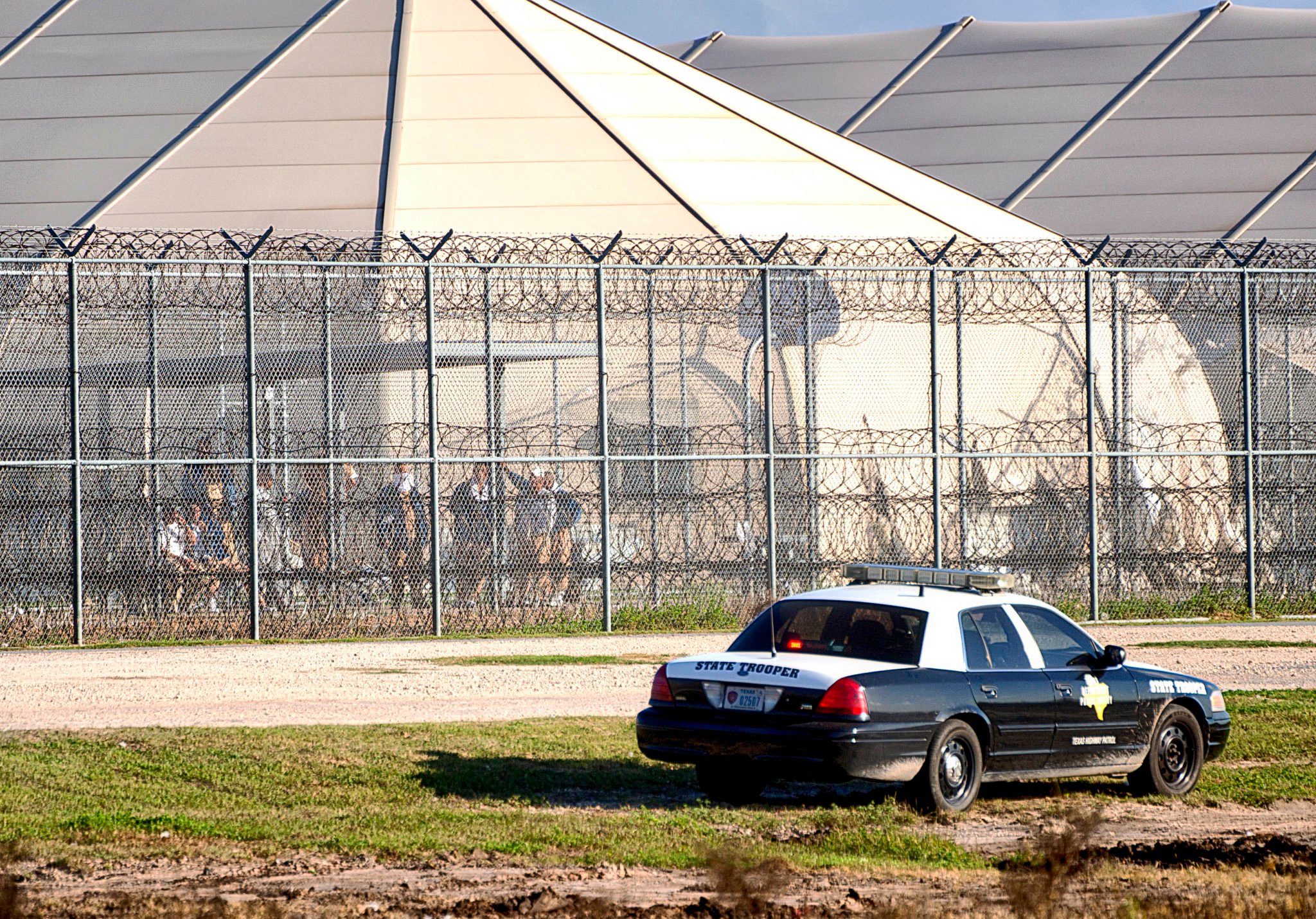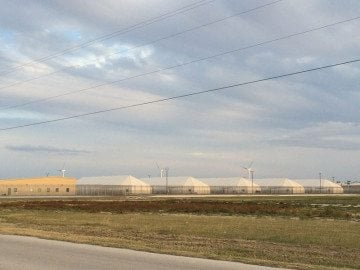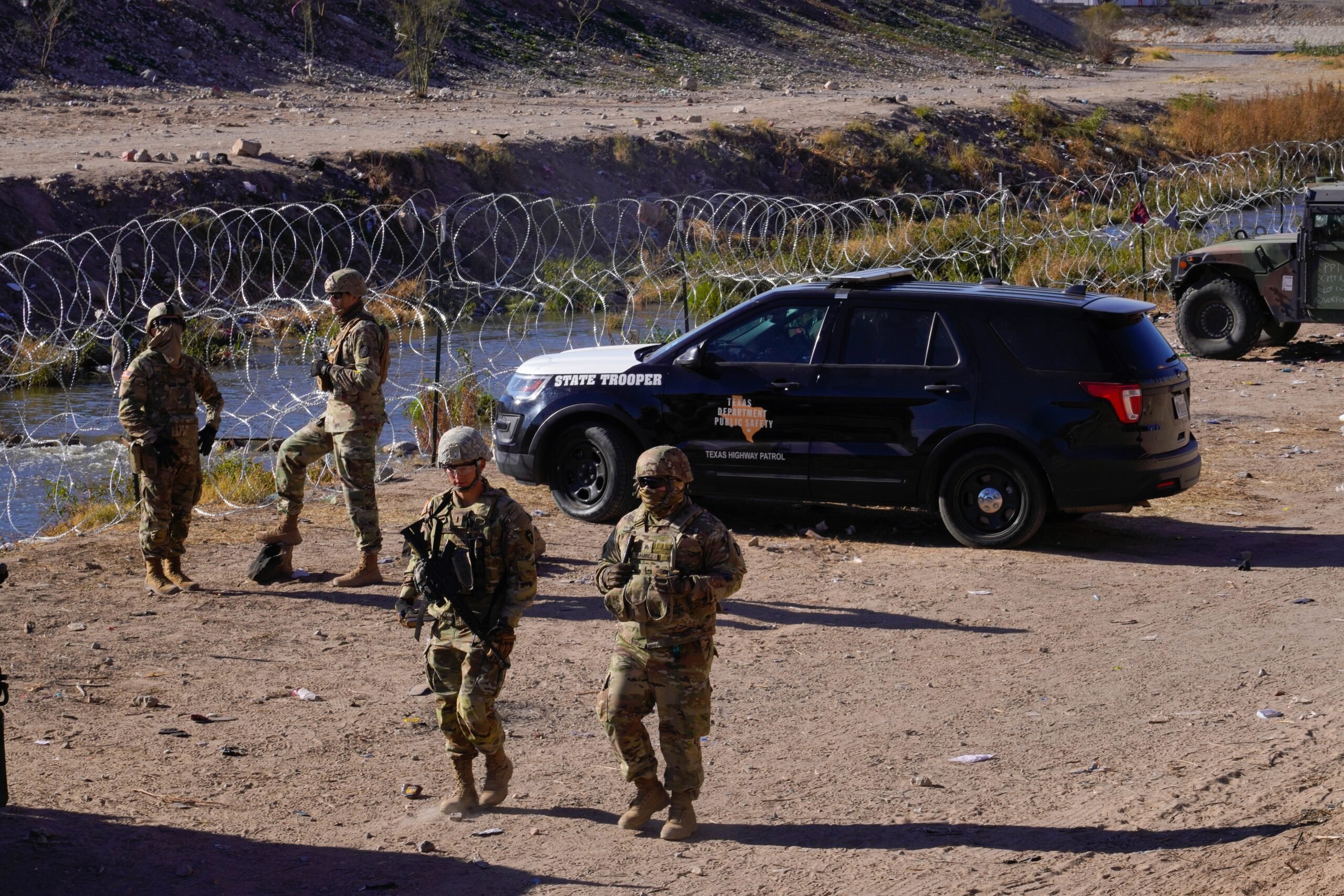
Goodbye to Tent City
After a riot destroys a for-profit prison, Willacy County ponders its economic future.
Above: Prisoners stand at the western fence as law enforcement officials from a wide variety of agencies converge on the Willacy County Correctional Center in Raymondville on Feb. 20 in response to a prisoner uprising at the private immigration detention center.
When I arrived at the prison on an overcast Tuesday afternoon in March, the first thing I noticed was the trash. Piled up along the razor-wire fence were hundreds of plastic garbage bags bulging with pieces of broken toilets and destroyed electronic surveillance equipment—the leftovers of a prison revolt that rocked Willacy County Correctional Center in Raymondville just a few weeks earlier.
On Feb. 20, prisoners wielding pipes, sharpened broomsticks and kitchen knives seized control of the privately run federal prison for nearly two days. The prisoners—undocumented immigrants awaiting deportation while serving federal criminal sentences, many for illegally entering the U.S.—mutinied after years of built-up exasperation over inadequate medical care, filthy toilets and maggot-infested food. They set fire to three of the 10 Kevlar tents that lend the South Texas prison its nickname, Tent City, and damaged the plumbing and electrical systems. The FBI was called in to negotiate; armored vehicles were sent inside; tear gas was fired. Somehow, the inmates managed to slice open the tents that hadn’t been torched. Willacy County Sheriff Larry Spence told reporters that inmates were “pouring out like ants coming out of an ant hill.” By the time prison authorities regained control of the prison, the $60 million facility was reduced to a shambles; the federal Bureau of Prisons declared it “uninhabitable.”
In the riot’s wake, all 2,834 inmates were transferred to other facilities. Nearly all of the 400 people employed by Management and Training Corporation (MTC), the private company the federal Bureau of Prisons (BOP) paid to run the prison, were laid off. When I traveled to Raymondville, an impoverished town 50 miles north of Brownsville, Willacy County leaders were waiting to see how long it might take for the prison to reopen—or if it would reopen at all. A decade ago, persuaded by a consortium of private prison salesmen, the county had entered into a kind of Faustian bargain, staking its financial future on a continual supply of state and federal prisoners. Now, as Willacy County faces a gaping hole in its budget, $128 million in debt still owed on Tent City, and the loss of its largest employer, I’d come to find out if the prison that was supposed to be the county’s economic salvation would end up being its undoing.
As Willacy County faces a gaping hole in its budget, $128 million in debt still owed on Tent City, and the loss of its largest employer, I’d come to find out if the prison that was supposed to be the county’s economic salvation would end up being its undoing.
At Tent City, the parking lot was nearly empty, but the two lock-ups next door—the Willacy County State Jail, operated by Corrections Corporation of America, and the Willacy County Regional Detention Center, a U.S. Marshals Service prison also contracted to MTC—were bustling. Drivers lined up three or four deep at the gate to have their IDs scrutinized by the guards. Before the riot, the three prisons in this sprawling complex could house up to 4,500 inmates, roughly a quarter of the county’s population. The prisons are so central to the area’s identity that locals have given their town a nickname that’s stuck: Prisonville.
Raymondville’s motto is “The City with a Smile.” The city’s water tower is emblazoned with a blue-on-white smiley face, though the paint is faded and rust creeps across its surface. Before the riot, the city had plans to repaint it. There were also plans to repair the historic courthouse, which was closed because of a mold problem. A custodian directed me to the new $1.2 million administrative building next door—financed, like most things in Willacy County, with prison revenue.
At the courthouse, County Commissioner Eliberto Guerra welcomed me to his office. He wore a red-and-black plaid shirt, a cowboy hat and tinted glasses. He was in a hurry, because U.S. Rep. Filemon Vela, Jr. was expected soon for a meeting with county officials to talk about the prison. Guerra was friendly and gregarious, but wary of the media, which he felt hadn’t portrayed a fair picture of the county and its leaders. Like almost everyone I met in Raymondville, he believed that the prison had been a benefit to the county. “It’s been a good investment,” he told me. “Yep, for a county like we are—rural county, no jobs—it’s hard for us.”
Guerra, like most officials I spoke with, didn’t think that the BOP would ever use tents again (“Everybody saw what happened, you know,” he said). Guerra said he does envision reopening a 1,000-bed permanent-structure building that was added in 2007 adjacent to the 2,000-bed tents. The tents could eventually be replaced with new structures, he said, perhaps financed by additional debt. Given the prison’s proximity to the border, and its size, he didn’t think that the BOP would even consider pulling out entirely. “I don’t see a problem,” he told me.
Across town, Catalina Ozuna, director of Raymondville’s economic development corporation, had already scheduled three job fairs for former MTC employees. (The first featured Corrections Corporation of America, which operates the neighboring state jail). Nonetheless, she said, the border crackdown would keep Prisonville in business. “I don’t see illegal immigrants coming into the United States coming to an end anytime soon,” she told me. “Those facilities will always be needed, no matter how many people complain that they’re in here, no matter how many people complain that they are privately owned. That is something—it’s like doctors. The jobs for doctors will always be in demand.”
But what if she is wrong? What if the feds just move on, or the border-security mania thaws?
No one in Raymondville wanted to say the “D” word out loud: default. “The only way we’ll find out is if it was to happen,” County Judge Aureliano Guerra told me when I asked about the effects on the county if the prison were to close. “Hopefully it won’t happen, and I’m certainly not going to start looking into it, either.”
Others, though, aren’t waiting. In late March, Standard and Poor’s, the rating agency, downgraded the prison bonds to “junk” status, potentially making it much more difficult for the county to borrow again—even just to pay for replacement buildings for the destroyed tents. “We believe the financial commitment appears to be unsustainable in the long-term,” S&P said in a statement, leaving the bonds “vulnerable to nonpayment” within 12 months.

Closer to home, county auditor Ida Martinez explained that the county relied on the BOP revenue to service both $8 million in annual debt payments as well as more than a quarter of the county’s $8 million operating budget. “Impossible,” Martinez said, when I asked her if the county could find a way to plug the hole in its budget. “Well, not impossible, but at least not in the near future.” Without the prison revenue, in just a few months the county would be forced to make difficult choices. “Health insurance [for county employees] goes first,” Martinez said, “then hiring freezes, then a reduction in force.”
“Worst-case scenario, if that does happen,” Commissioner Guerra said, “it’s going to be devastating for our county, financially. And then, pues, we’re going to have to make some cuts, or—how are we going to deal with this?”
Questions like these prompted at least one lonely critic in the county to speak out when the bonds were refinanced in 2011 to fund renovations requested by BOP. “This is a staggering amount of debt,” District Attorney Bernard Ammerman told the Raymondville Chronicle then. “We are going to hit an iceberg.”
Now that the iceberg appears to have been struck, Ammerman seems perturbed at having to repeat himself. “I said it before,” he said when I caught up with him in the hallway outside of his office. “It’s just a large sum.” Dressed in business casual, he appeared to be in his mid-30s, a generation younger than every one of his county government colleagues I met. “You’re not from Willacy, are you?” he asked. “The county of Willacy is small. When you have [$128 million] outstanding—if we were Harris County, it would be a drop in the bucket. But for us…” He trailed off.
When private prison representatives first showed up in Willacy County in the 1990s, they distributed spreadsheets promising millions of dollars a year for a county whose major source of income, agriculture, was in decades-long decline. They even suggested the possibility that all local taxes could eventually be eliminated. And because the bonds would be issued not by the county but by a quasi-governmental organization known as a local government corporation, all that revenue—and the debt to finance it—would be virtually risk-free, they said.
For county leaders whose budget was in the red, the temptations proved impossible to resist.
The Willacy County State Jail opened in 1996, followed by the Willacy County Regional Detention Center in 2003 and Tent City in 2006. Completed at an initial cost of $60 million, Tent City was the largest detention center in the country at the time. All those beds were needed because the Bush administration was rushing to implement Operation Streamline, a policy shift under which immigrants detained at the border were prosecuted through the federal criminal justice system, rather than immediately deported. After a personal appeal by Homeland Security Director Michael Chertoff, the tents were constructed in just 45 days.
From the beginning, problems followed the prison. In 2005, two Willacy County commissioners were convicted of accepting bribes in exchange for their votes to approve the project, and a Webb County commissioner was convicted of funneling the bribe.
About half of these inmates were doing time for “illegal entry or reentry”—crossing the border—a crime that makes up the fastest-growing percentage of federal prosecutions. In 2013, 88 percent of federal prosecutions in South Texas were for immigration offenses.
Reports also began to surface about awful conditions inside the tents. A 2007 American Bar Association delegation flagged inmate complaints about lack of access to lawyers and medical care, rodents, flooding toilets and water seeping underneath the tents during rainfall. (In 2014, the county sued construction company Hale-Mills for $65 million, alleging shoddy construction. The case is still pending.)
In 2011, immigrant-rights groups hailed the decision by Immigration and Customs Enforcement (ICE) and the Obama administration not to renew MTC’s contract, but Tent City wasn’t done yet.
As an ICE facility, the prison had housed undocumented immigrants being held in civil detention while waiting to be deported or for their cases to be heard. Now, quietly, BOP announced that the facility would instead become a “criminal alien requirement” prison—a federal facility housing non-citizens scheduled for deportation once their criminal sentences ended. About half of these inmates were doing time for “illegal entry or reentry”—crossing the border—a crime that makes up the fastest-growing percentage of federal prosecutions. In 2013, 88 percent of federal prosecutions in South Texas were for immigration offenses.
The new contract with BOP contained an important provision that the ICE contract lacked: It guaranteed a minimum payment—$48 million in 2015—that was based on a 90 percent capacity rate, and would be paid even if the prison was empty. The feds paid MTC an additional per diem for inmates beyond that 90 percent threshold. With ICE, the prison had sometimes operated at less than one-quarter capacity.
It was a great deal for MTC and the county, but the guaranteed payments meant BOP had an incentive to fill the prison, often to the point of being over capacity. In its first year, the BOP contract generated nearly three times as much income for the county as the ICE contract ever had.
While the county’s financial position improved, what didn’t change was the company that operated the prison, MTC, and its record of abysmal conditions. In a 2014 report, the ACLU detailed many of the same complaints that the ABA had reported, adding a new one: overcrowding. Two hundred inmates slept in each tent, with only three feet between beds. New inmates, the report stated, were routinely forced to stay in Special Housing Unit cells, or solitary confinement. The contract stipulated that 10 percent of the beds be SHU units, so as the facility became more crowded, solitary confinement became the only place to put detainees.
Tensions ran high and sometimes boiled over. In 2012, inmates protested after the water was turned off for two days (it had been running yellow-green for weeks), and up to 80 inmates subsequently were sent to Special Housing Units. The next year, inmates held a strike in the rec yard, refusing to return to the tents until the toilets were fixed. “It’s like walking through minefields,” one prisoner told an ACLU investigator. “You never know when someone is going to explode, because everyone is frustrated.”
Another prisoner warned, presciently, that inmates had threatened to burn down the tents. Still, he said, “What’s the point? They’d build them back up.”
Before I left Raymondville, I drove one last time through the two-block downtown, past the old movie theater with the regal “Texas” marquee (it’s now a hair salon), past the shuttered Dollar General, past no fewer than seven shops specializing in one form or another of quick loans and easy credit. Everybody, it seemed, was up to their necks in debt. It wasn’t hard to imagine why Willacy County might have been willing to wager its future on the private prison industry. Maybe folks here felt like they didn’t have much to lose in the first place.
In reality, though, Willacy County had a lot to lose. MTC will be fine, of course. According to its website, MTC “safely secures more than 31,000 offenders in eight states at 25 facilities.” And while MTC is privately held—so it doesn’t have to disclose financials—CCA, the for-profit prison behemoth that runs the state jail next door, reported 2012 profits equivalent to $17.53 per prisoner per day. But for MTC’s 400 former employees, the future is not as bright. Where are they going to find a job, any job, let alone one that pays $14.95 an hour with the only prerequisite being a relatively clean record and a high school diploma? The development corporation’s Ozuna told me that after the first day of the job fair, five ex-MTC employees had found jobs. Only 395 to go.
Before getting back on the highway, I stopped at Tent City. The clouds that had been gathering for the two days I spent in Raymondville unleashed a torrential downpour. I rolled down the window. From what I could see, most of the trash had been taken away. As for the tents, I could barely make out their outline through the rain. If I didn’t know better, I wouldn’t have known they were there at all.
When I left Raymondville, county leaders were still hopeful that the prison would soon be rebuilt and reopened. Back at home the following Monday afternoon, though, I got a call from Congressman Vela’s office; I’d called from Raymondville to see how the meeting went and hadn’t heard back. Now, his staff had news to deliver: The BOP had decided to cancel its contract. At least for the foreseeable future, Tent City is out of business.


